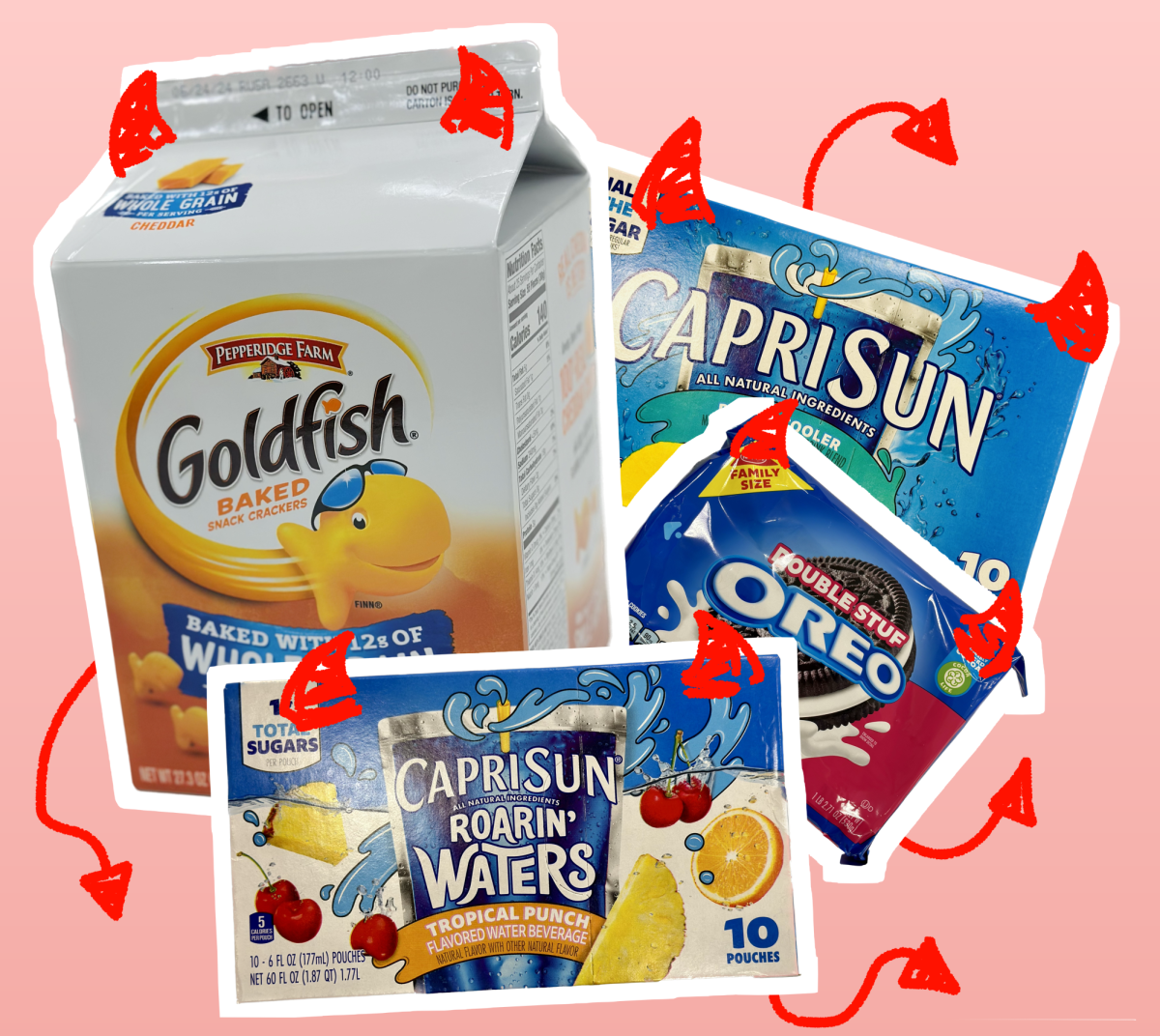In place of goldfish are air-fried croutons, instead of Minute Maid is lemon-lime sparkling water turned still. In a world where “Instagram-worthy” salads often overshadow childhood classics, diet culture has reshaped the snacks that once fueled our youthful spirits.
This shift in focus has transformed the essence of childhood snacks, and not for the better. Diet culture casts a shadow over what used to be joyful moments of indulgence. The result? A new generation of childhood snacks that often falls short in terms of quality and, more importantly, what I like to call the “happiness factor.”
The first and most noticeable victim of diet culture is everyone’s least-favorite carbohydrate, sugar. While it’s essential to address the issue of excessive sugar consumption, the pendulum has swung too far in the opposite direction. Many classic childhood beverages, once beloved for their sweetness, now come in “sugar-free” or “diet” versions that lack the flavor and appeal of their full-sugar counterparts. Of course, constant consumption of sugary foods isn’t healthy for anyone, and likely is the reason for rising obesity rates in children — but the problem lies in a lack of moderation, not the existence of non-diet foods.
The most egregious violation, in my experience, has been the replacement of sugar with monk-fruit extract in juices such as Capri Sun. In my childhood, there was no advertising as “sugar-free” or “reduced-sugar”: the best we were going to get was “made from real fruit concentrate,” and that’s all we needed.
After a hot day of summer activities, I always knew there would be a Yeti cooler filled with juice pouches provided by camp counselors. Fruit punch, strawberry kiwi, sometimes even pacific cooler: the from-concentrate flavors are forever tied to summer-sweet memories of nostalgia.
Nowadays, what once were joy-filled juice pouches feel soulless as they drain down my gullet: the apple-flavor is less crisp, the strawberry less juicy. The excitement has been sucked out of these once-uplifting refreshments. There is no “happiness factor.” Children are left with artificially sweetened, bland options that do little to evoke the simple pleasure of a tasty snack.
Driven by a confluence of factors such as social media, the fitness industry and the pursuit of idealized body images, the growth of diet culture in recent years resulted in a pervasive obsession with weight, body size and restrictive eating patterns. Perpetuating the stigmatization of larger bodies, it reinforces harmful stereotypes and fosters a culture of judgment and discrimination.
By nurturing a healthy relationship with food, children grow up with a genuine appreciation for the joy that comes from savoring life’s simple pleasures, including their favorite snacks
Diet culture’s impact on childhood snacks goes beyond sugar. It has infiltrated other aspects of snack offerings. The demand for low-calorie and low-fat options has led to the creation of snacks that are, frankly, disappointing in terms of flavor. Kids are missing out on the delightful experience of enjoying a little treat as they are served bland, cardboard-like alternatives that leave them unfulfilled. Instead of delivering on the promise of tasty so-called “health,” new-age snacks remind us that sometimes, less really is less.
Moreover, diet culture breeds a fear of indulgence and an unhealthy relationship with food in children from an early age. Instead of teaching them to enjoy treats in moderation, we promote the notion that certain foods are inherently “bad” and should be avoided at all costs. This results in guilt, anxiety and a damaging perspective on eating.
Happiness is a vital ingredient in a child’s life. Snacks are an integral part of creating lasting, joyful memories, but diet culture has diminished this to a question of calories. Recognize that happiness and health can coexist. Teach children about balance, moderation and the importance of enjoying life’s pleasures without succumbing to the pressures of unrealistic dietary standards.
While promoting healthier options is essential, emphasize also the importance of taste, enjoyment and balance in children’s lives. By nurturing a healthy relationship with food, children grow up with a genuine appreciation for the joy that comes from savoring life’s simple pleasures, including their favorite snacks. It’s time to put the joy (and if the joy presents itself as sugar, so be it) back into childhood snacking and let kids relish the happiness it brings.
This story was originally published on Harker Aquila on November 29, 2023.





![With the AISD rank and GPA discrepancies, some students had significant changes to their stats. College and career counselor Camille Nix worked with students to appeal their college decisions if they got rejected from schools depending on their previous stats before getting updated. Students worked with Nix to update schools on their new stats in order to fully get their appropriate decisions. “Those who already were accepted [won’t be affected], but it could factor in if a student appeals their initial decision,” Principal Andy Baxa said.](https://bestofsno.com/wp-content/uploads/2024/05/53674616658_18d367e00f_o-1200x676.jpg)






![Junior Mia Milicevic practices her forehand at tennis practice with the WJ girls tennis team. “Sometimes I don’t like [tennis] because you’re alone but most of the time, I do like it for that reason because it really is just you out there. I do experience being part of a team at WJ but in tournaments and when I’m playing outside of school, I like that rush when I win a point because I did it all by myself, Milicevic said. (Courtesy Mia Milicevic)](https://bestofsno.com/wp-content/uploads/2024/06/c54807e1-6ab6-4b0b-9c65-bfa256bc7587.jpg)








![The Jaguar student section sits down while the girls basketball team plays in the Great Eight game at the Denver Coliseum against Valor Christian High School Feb. 29. Many students who participated in the boys basketball student section prior to the girls basketball game left before half-time. I think it [the student section] plays a huge role because we actually had a decent crowd at a ranch game. I think that was the only time we had like a student section. And the energy was just awesome, varsity pointing and shooting guard Brooke Harding ‘25 said. I dont expect much from them [the Golden Boys] at all. But the fact that they left at the Elite Eight game when they were already there is honestly mind blowing to me.](https://bestofsno.com/wp-content/uploads/2024/05/IMG_7517-e1716250578550-900x1200.jpeg)









![BACKGROUND IN THE BUSINESS: Dressed by junior designer Kaitlyn Gerrie, senior Chamila Muñoz took to the “Dreamland” runway this past weekend. While it was her first time participating in the McCallum fashion show, Muñoz isn’t new to the modeling world.
I modeled here and there when I was a lot younger, maybe five or six [years old] for some jewelry brands and small businesses, but not much in recent years,” Muñoz said.
Muñoz had hoped to participate in last year’s show but couldn’t due to scheduling conflicts. For her senior year, though, she couldn’t let the opportunity pass her by.
“It’s [modeling] something I haven’t done in a while so I was excited to step out of my comfort zone in a way,” Muñoz said. “I always love trying new things and being able to show off designs of my schoolmates is such an honor.”
The preparation process for the show was hectic, leaving the final reveal of Gerrie’s design until days before the show, but the moment Muñoz tried on the outfit, all the stress for both designer and model melted away.
“I didn’t get to try on my outfit until the day before, but the look on Kaitlyn’s face when she saw what she had worked so hard to make actually on a model was just so special,” Muñoz said. “I know it meant so much to her. But then she handed me a blindfold and told me I’d be walking with it on, so that was pretty wild.”
Caption by Francie Wilhelm.](https://bestofsno.com/wp-content/uploads/2024/05/53535098892_130167352f_o-1200x800.jpg)








